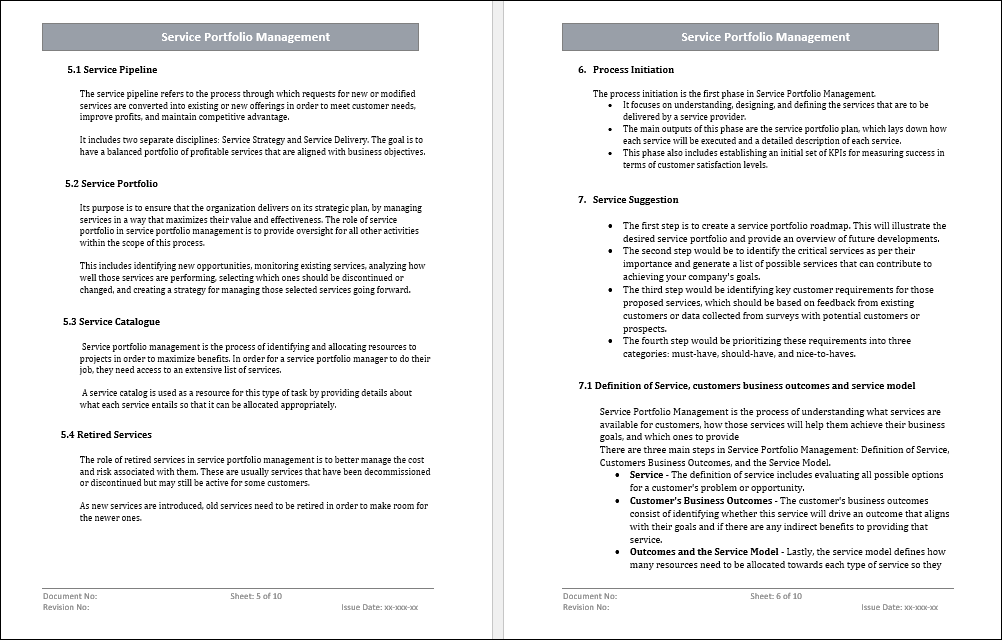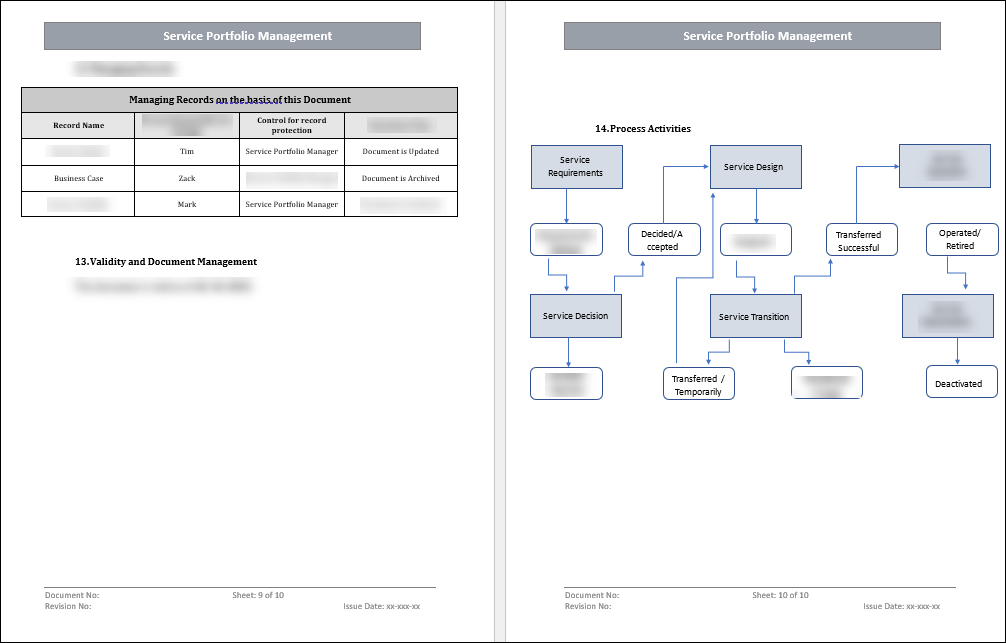Service Portfolio Management Template
Introduction
Service Portfolio Management (SPM) Template in IT Governance refers to the systematic and strategic approach of organizing, categorizing, and managing an organization's suite of IT services. It involves the creation of a comprehensive template that encompasses the entire lifecycle of IT services, from ideation to retirement. This template typically includes elements such as a service catalog, service pipeline, and retired services, providing a structured framework for decision-making, resource allocation, and alignment with business objectives. SPM enables organizations to gain visibility into their IT service landscape, optimize costs, enhance risk management, and ultimately deliver maximum value to both internal and external stakeholders. The template serves as a guide for IT leaders in effectively planning, implementing, and maintaining a dynamic and responsive portfolio of services that align with the evolving needs of the business.

Importance Of Service Portfolio Management Template
The Service Portfolio Management (SPM) template is of paramount importance in IT governance as it serves as a strategic compass for organizations seeking to align their IT services with overarching business objectives. By providing a structured framework that encompasses the entire lifecycle of IT services, the template enables a systematic approach to decision-making, resource allocation, and risk management. It enhances visibility into the service landscape, allowing stakeholders to gain a comprehensive understanding of current, future, and retired services. This visibility is crucial for informed decision-making, ensuring that IT initiatives are closely aligned with the strategic direction of the organization.
Implemention Of Service Portfolio Management Template
Below is a step-by-step guide to effectively implement the Service Portfolio Management Template:
1. Assessment of Current Services:
- Conduct a thorough inventory and assessment of existing IT services to create a baseline understanding.
- Identify the key stakeholders involved in each service and gather their input on the current state and future requirements.
2. Creation of Initial Portfolio:
- Develop the initial SPM template by categorizing existing services into relevant groups.
- Clearly define the criteria for categorization, considering factors such as business impact, strategic alignment, and resource requirements.
3. Defining Service Catalog:
- Establish a comprehensive service catalog within the SPM template, detailing the features, functionalities, and dependencies of each service.
- Ensure that the service catalog is regularly updated to reflect changes in service offerings and requirements.
4. Service Pipeline Development:
- Introduce a service pipeline within the SPM template to identify potential new services.
- Prioritize services based on their strategic importance, alignment with business goals, and potential impact on organizational efficiency.
5. Involvement of Key Stakeholders:
- Engage with key stakeholders, including business leaders, IT teams, and end-users, throughout the SPM implementation process.
- Solicit feedback on the categorization of services, ensuring that the template aligns with the organization's strategic priorities.
6. Utilization of Technology:
- Leverage IT management tools and software to facilitate the implementation and ongoing management of the SPM template.
- Integrate the SPM template with existing IT Service Management (ITSM) tools for seamless coordination and data consistency.
7. Establishing Governance Processes:
- Develop governance processes to regularly review and update the SPM template.
- Define roles and responsibilities for stakeholders involved in managing and maintaining the service portfolio.

Benefits Of Service Portfolio Management Template
- Strategic Alignment: The SPM template facilitates the alignment of IT services with overall business objectives.
- Visibility and Transparency: Improved visibility into the entire service landscape allows stakeholders to understand the status of current services, upcoming initiatives, and retired services.
- Optimized Resource Allocation: The SPM template enables organizations to categorize and prioritize services based on their strategic importance and value.
- Risk Management: Risk Management includes the identification and assessment of potential risks associated with each service, the SPM template helps organizations proactively manage and mitigate risks.
- Informed Decision-Making: With a comprehensive service catalog and pipeline, decision-makers have access to detailed information about each service.
- Cost Optimization: By providing insights into the costs associated with each service, the SPM template supports organizations in optimizing their IT budgets.
Conclusion
The implementation of a Service Portfolio Management (SPM) template stands as a cornerstone in the realm of IT governance, providing organizations with a powerful tool to strategically manage their suite of IT services. The SPM template offers a structured framework that aligns IT services with overarching business goals, fostering transparency, adaptability, and efficiency throughout the service lifecycle. The benefits derived from the SPM template are manifold. From optimized resource allocation and enhanced risk management to improved decision-making and cost optimization, organizations gain a comprehensive approach to managing their IT service portfolio.


